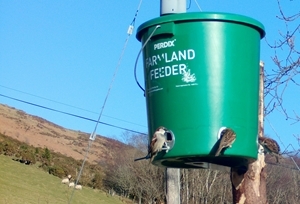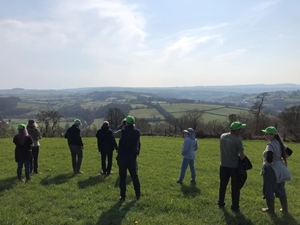For those who work in the British countryside, it has become common knowledge that farmland birds are struggling. In the latest Birds of Conservation Concern review, 14 of the 26 farmland birds in the UK have been assigned to the Red List. The reasons behind the declines in these species are numerous, however one of particular relevance to seed-eating birds in Wales is the loss of mixed farming.
In the last century, the transition to more livestock-based farming resulted in the loss of seed-rich habitats in Wales. As a result, this has led to a reduction in the amount of food available for seed-eating farmland birds during the winter months. This problem is emphasised later in the winter, when any seed that was available in the landscape has been depleted, resulting in what is referred to as the “over-winter hungry gap”.
 One way of overcoming this issue is to provide supplementary seed via farmland feeders. By positioning farmland feeders near appropriate farmland bird habitats such as hedgerows, trees or cover crops, farmers simply need to ensure that the feeders are filled with seed regularly between December and April. This simple and cost-effective method ensures that there is a consistent and plentiful supply of food available for small seed-eating birds to feed on throughout the winter months. This inspired a GWCT-led pilot project in north-east Wales.
One way of overcoming this issue is to provide supplementary seed via farmland feeders. By positioning farmland feeders near appropriate farmland bird habitats such as hedgerows, trees or cover crops, farmers simply need to ensure that the feeders are filled with seed regularly between December and April. This simple and cost-effective method ensures that there is a consistent and plentiful supply of food available for small seed-eating birds to feed on throughout the winter months. This inspired a GWCT-led pilot project in north-east Wales.
Following on from the great success of this pilot project, GWCT Wales entered a collaborative project with the Ceredigion Local Nature Partnership, with the ambition of encouraging farmers across Ceredigion to perform supplementary feeding. A mostly cattle and sheep farming county, the objective of this project was to not only raise awareness of the use of this conservation technique in the pastoral landscape of Ceredigion, but also to engage farmers with the bird life they have on their farms.
Using funding from the Welsh Government, the project started last October, with 25 farms across Ceredigion being provided with a single Perdix Farmland Feeder and 250kg of small seed mix from Kings Crops, enough to last the duration of the hungry gap. Each farmer was then advised as to the most appropriate place to locate the feeders in order to maximise the likelihood of them being utilised by seed-eating birds.
Indeed, the amount the feeders have been used by farmland birds has varied from farm to farm, with feeders occasionally being moved to more appropriate spots where there has been limited use. On the other hand, use by grey squirrels has been to the contrary, with some feeders seeing an abundance of squirrels which have damaged feeders and deterred birds. As a part of the project, camera traps have been deployed in order to capture what is using the feeders, and to record the timings of visitations by different species.
 Nevertheless, with the feeders established, farmers participating in the project were later encouraged to take part in the Big Farmland Bird Count. An event was organised on one of the farms participating in the project to provide support on species identification, with an informal farm walk allowing for long-awaited discussions and catch-ups between farmers following the easing of COVID restrictions.
Nevertheless, with the feeders established, farmers participating in the project were later encouraged to take part in the Big Farmland Bird Count. An event was organised on one of the farms participating in the project to provide support on species identification, with an informal farm walk allowing for long-awaited discussions and catch-ups between farmers following the easing of COVID restrictions.
The participating farms are spread across Ceredigion, from the banks of the River Teifi to the edges of the Cambrian Mountains. Whilst some of the farms are relatively isolated, others are neighbouring farms who share boundaries. Nevertheless, farming can be a solitary lifestyle, so hopefully this project has improved the well-being of the participating farmers by engaging them with their farmland wildlife. By doing so, it has provided an introduction to carrying out additional conservation practices on their farms.
